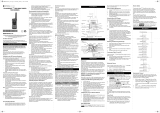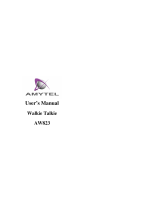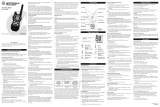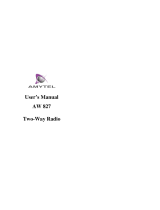Page is loading ...



Contents
Contents
Safety and General Information ...................... 2
FCC Licensing Information................................10
Control Buttons..................................................11
Getting Started ..................................................13
Installing the AA Batteries ..............................13
Installing the NiMh Battery Pack ....................13
Battery Meter....................................................14
Attaching the Belt Clip ....................................15
Removing the Belt Clip....................................15
Turning Your Radio On and Off ......................15
Setting the Volume ..........................................15
Setting a Channel ............................................16
Channels and Frequencies..............................16
Talking and Listening ........................................17
Talk Range ........................................................17
Checking the Channel Before Transmitting ..17
Special Features ................................................18
Interference Eliminator Code..........................18
Push to Talk Timeout Timer ............................18
Locking the Keypad ........................................18
Scanning Channels ..........................................19
Advanced Scan ................................................19
Alerts ..................................................................20
Channel Busy Indicator ..................................20
Setting and Transmitting Call Tones ..............20
Transmitting a Talk Confirmation Tone..........21
QT Noise Filtering ............................................21
Accessories ........................................................23
Using Audio Accessories ................................23
Hands-Free Use with Accessories ..................23
Hands-Free Use (iVOX) without Accessories....24
Patent Information ............................................25
Copyright Information ......................................26
Warranty ............................................................27
1

Safety and General Information
Safety and General Information
Important Information on Safe and Efficient Operation
Read This Information Before Using Your Radio.
The information provided in this document supersedes the general safety
information in user guides published prior to December 1, 2002.
Transmit and Receive Procedure
Your two-way radio contains a transmitter and a receiver. To control your
exposure and ensure compliance with the general population/uncontrolled
environment exposure limits, always adhere to the following procedure:
• Transmit no more than 50% of the time.
• To transmit (talk), press the Push to Talk (PTT) button.
• To receive calls, release the PTT button.
Transmitting 50% of the time, or less, is important because the radio generates
measurable RF energy exposure only when transmitting (in terms of measuring
standards compliance).
Exposure To Radio Frequency Energy
Your Motorola two-way radio complies with the following RF energy exposure
standards and guidelines:
• United States Federal Communications Commission, Code of Federal
Regulations; 47CFR part 2 sub-part J
2

Safety and General Information
• American National Standards Institute (ANSI) / Institute of Electrical and Electronic
Engineers (IEEE) C95. 1-1992
• Institute of Electrical and Electronic Engineers (IEEE) C95.1-1999 Edition
• International Commission on Non-Ionizing Radiation Protection (ICNIRP) 1998
• Ministry of Health (Canada) Safety Code 6. Limits of Human Exposure to
Radiofrequency Electromagnetic Fields in the Frequency Range from 3 kHz to 300
GHz, 1999
• Australian Communications Authority Radiocommunications (Electromagnetic
Radiation --- Human Exposure) Standard, 2003
• ANATEL ANNEX to Resolution No. 303 of July 2, 2002 "Regulation of limitation of
exposure to electrical, magnetic and electromagnetic fields in the radio frequency
range between 9 KHz and 300 GHz" and "Attachment to resolution # 303 from July
2, 2002"
To assure optimal radio performance and make sure human exposure to radio
frequency electromagnetic energy is within the guidelines set forth in the above
standards, always adhere to the following procedures.
Portable Radio Operation and EME Exposure
Antenna Care
Use only the supplied or an approved replacement antenna. Unauthorized
antennas,modifications, or attachments could damage the radio and may violate
FCC regulations.
DO NOT hold the antenna when the radio is “IN USE.” Holding the antenna affects
the effective range.
3

Safety and General Information
Two-way Radio Operation
When using your radio as a traditional two-way radio, hold the radio in
a vertical position with the microphone 1 to 2 inches (2.5 to 5 cm)
away from the lips.
Body-Worn Operation
To maintain compliance with FCC/Health Canada RF exposure guidelines, if you
wear a radio on your body when transmitting, always place the radio in a Motorola-
supplied or approved clip, holder, holster, case, or body harness for this product.
Use of non-Motorola-approved accessories may exceed FCC/Health Canada RF
exposure guidelines.
If you do not use one of the Motorola-supplied or approved body-worn accessories,
and are not using the radio held in the normal use position, ensure the radio and its
antenna are at least 1 inch (2.5 cm) from your body when transmitting.
Data Operation
If applicable, when using any data feature of the radio with or without an accessory
cable, position the radio and its antenna at least 1 inch (2.5 cm) from the body.
Approved Accessories
For a list of approved Motorola accessories, visit our website at www.Motorola.com.
Electromagnetic Interference/Compatibility
Note: Nearly every electronic device is susceptible to electromagnetic interference
(EMI) if inadequately shielded, designed, or otherwise configured for electro-
magnetic compatibility.
4

Safety and General Information
Facilities
To avoid electromagnetic interference and/or compatibility conflicts, turn off your
radio in any facility where posted notices instruct you to do so. Hospitals or health
care facilities may be using equipment that is sensitive to external RF energy.
Aircraft
When instructed to do so, turn off your radio when on board an aircraft. Any use
of a radio must be in accordance with applicable regulations per airline crew
instructions.
Medical Devices - Pacemakers
The Advanced Medical Technology Association recommends that a minimum
separation of 6 inches (15 cm) be maintained between a handheld wireless radio
and a pacemaker. These recommendations are consistent with the independent
research by, and recommendations of the U.S. Food and Drug Administration.
Persons with pacemakers should:
• ALWAYS keep the radio more than 6 inches (15 cm) from their pacemaker when
the radio is turned ON.
• Not carry the radio in the breast pocket.
• Use the ear opposite the pacemaker to minimize the potential for interference.
• Turn the radio OFF immediately if you have any reason to suspect that
interference is taking place.
5

Safety and General Information
Medical Devices - Hearing Aids
Some digital wireless radios may interfere with some hearing aids. In the event
of such interference, you may want to consult your hearing aid manufacturer to
discuss alternatives.
Other Medical Devices
If you use any other personal medical device, consult the manufacturer of your
device to determine if it is adequately shielded from RF energy. Your physician
may be able to assist you in obtaining this information.
Safety and General Use While Driving
Check the laws and regulations on the use of radios in the area where you drive.
Always obey them. When using your radio while driving, please:
• Give full attention to driving and to the road.
• Use hands-free operation, if available.
• Pull off the road and park before making or answering a call if driving
conditions so require.
Operational Warnings
For Vehicles with an Air Bag
Do not place a portable radio in the area over an air bag or in the air bag deploy-
ment area. Air bags inflate with great force. If a portable radio is placed in the air
bag deployment area and the air bag inflates, the radio may be propelled with
great force and cause serious injury to occupants of the vehicle.
6

Safety and General Information
Potentially Explosive Atmospheres
Turn off your radio prior to entering any area with a potentially explosive
atmosphere, unless it is a radio type especially qualified for use in such areas as
“Intrinsically Safe.”
Do not remove, install, or charge batteries in such areas. Sparks in a potentially
explosive atmosphere can cause an explosion or fire resulting in bodily injury or
even death.
Note: The areas with potentially explosive atmospheres referred to above include
fueling areas such as below decks on boats, fuel or chemical transfer or
storage facilities, areas where the air contains chemicals or particles, such
as grain, dust, or metal powders, and any other area where you would nor-
mally be advised to turn off your vehicle engine. Areas with potentially
explosive atmospheres are often but not always posted.
Blasting Caps and Areas
To avoid possible interference with blasting operations, turn off your radio when
you are near electrical blasting caps, in a blasting area, or in areas posted: “Turn
off two-way radio.” Obey all signs and instructions.
Operational Cautions
Antennas
Do not use any portable radio that has a damaged antenna. If a damaged antenna
comes into contact with your skin, a minor burn can result.
7

Safety and General Information
Batteries
All batteries can cause property damage and/or bodily injury such as burns if a
conductive material such as jewelry, keys, or beaded chains touch exposed termi-
nals. The conductive material may complete an electrical circuit (short circuit) and
become quite hot. Exercise care in handling any charged battery, particularly
when placing it inside a pocket, purse, or other container with metal objects.
Battery Charger Safety Instructions
Save these Instructions
1. Do not expose the charger to rain or snow.
2. Do not operate or disassemble the charger if it has received a sharp blow, or
has been dropped or damaged in any way.
3. Never alter the AC cord or plug provided with the unit. If the plug will not fit
the outlet, have the proper outlet installed by a qualified electrician. An
improper condition can result in a risk of electric shock.
4. To reduce the risk of damage to the cord or plug, pull the plug rather than the
cord when disconnecting the charger from the AC receptacle.
5. To reduce the risk of electric shock, unplug the charger from the outlet before
attempting any maintenance or cleaning.
6. Use of an attachment not recommended or sold by Motorola may result in a
risk of fire, electric shock, or personal injury.
8

Safety and General Information
7. Make sure the cord is located so it will not be stepped on, tripped over, or
subjected to damage or stress.
8. An extension cord should not be used unless absolutely necessary. Use of an
improper extension cord could result in a risk of fire and/or electric shock. If an
extension cord must be used, make sure that:
• The pins on the plug of the extension cord are the same number, size and
shape as those on the plug of the charger.
• The extension cord is properly wired and in good electrical condition.
• The cord size is 18 AWG for lengths up to 100 feet, and 16 AWG for lengths up
to 150 feet.
9. The supply cord of this charger cannot be replaced. If the cord is damaged, call
Motorola Product Services at 1-800-353-2729 in USA or 1-888-390-6456 TTY
(Text Telephone).
9

FCC Licensing Information
FCC Licensing Information
Your Motorola radio operates on General Mobile Radio Service (GMRS) frequen-
cies and is subject to the Rules and Regulations of the Federal Communications
Commission (FCC). The FCC requires that all operators using GMRS frequencies
obtain a radio license before operating their equipment. To obtain the FCC forms,
please request Form
605 and 159, which includes all forms and instructions. If
you wish to have the document faxed or mailed, or have questions, please use
the following contact information.
Changes or modifications not expressly approved by Motorola may void the user’s
authority granted by the FCC to operate this radio and should not be made. To
comply with FCC requirements, transmitter adjustments should be made only by
or under the supervision of a person certified as technically qualified to perform
transmitter maintenance and repairs in the private land mobile and fixed services as
certified by an organization representative of the user of those services. Replacement
of any transmitter component (crystal, semiconductor, etc.) not authorized by the
FCC equipment authorization for this radio could violate FCC rules.
Note: Use of this radio outside the country where it was intended to be distributed
is subject to government regulations and may be prohibited.
10
Faxed
Contact the Fax-On-
Demand system at:
Mailed
Call the FCC forms
hotline at:
Questions
Regarding FCC license
Contact the FCC at:
1-202-418-0177
1-800-418-FORM
1-800-418-3676
1-888-CALL-FCC
1-888-225-5322
Or: http://www.fcc.gov

Control Buttons - Model T5000
Control Buttons - Model T5000
11
Use to:
• Select menu options
• Exit the menu (when
pressed while in a
menu)
• Lock and unlock the
keypad (when held
down and not in a
menu)
Accessory Jack
Use to:
• Scan
Use and to:
• Scroll through menus
Microphone
Use to:
• Turn radio on/off
• Adjust volume
LED Indicator Light
Use to:
• Talk
• Save a setting
Use to:
• Transmit call tone
Speaker

Control Buttons - Model T5500 and T5550
Control Buttons - Model T5500, T5530 and T5550
12
Use to:
• Select menu options
• Exit the menu (when
pressed while in a
menu)
• Lock and unlock the
keypad (when held
down and not in a
menu)
Accessory Jack
Use to:
• Scan
Use and to:
• Scroll through menus
Microphone
Use to:
• Turn radio on/off
• Adjust volume
LED Indicator Light
Use to:
• Talk
• Save a setting
Use to:
• Transmit call tone
Removeable front cover
Speaker

Getting Started
Getting Started
Installing the AA Batteries
Your radio uses 3 AA Alkaline batteries.
1. With the back of the radio facing you, lift the battery latch
up to release the battery cover and remove the cover.
2. Insert 3 AA Alkaline batteries as shown on the inside of the
battery compartment.
3. Reposition the battery cover and press down to secure.
Note: The T5000,T5500, T5530 and T5550 model radios can
use a NiMh rechargeable battery instead of 3 AA
Alkaline batteries. A rechargeable battery upgrade kit, is
available for these radios.
Installing the NiMh Battery Pack
1. Follow step 1 above to remove the battery cover.
2. Remove the battery pack from the clear plastic bag.
Do not disassemble or unwrap the battery pack.
3. Insert the NiMh battery pack so the metal contacts on the
side of the battery are facing outward from the radio to
connect with the contacts on the battery door.
4. Reposition the battery cover and press down to secure.
13

Getting Started
Battery Meter
The battery icon shows the battery charge level, from full to empty . When
the battery is empty, the radio chirps periodically after releasing . The radio powers
off when the voltage drops below a predetermined level to protect the rechargeable
battery.
Note: Remove the batteries before storing your radio for extended periods of time.
Batteries corrode over time and may cause permanent damage to your radio.
Using the Desk Stand Charger (Optional Accessory)
The desk stand charger provides drop-in charging convenience for NiMh batteries
and can be placed on any flat surface, such as a desk or workbench. Charge the NiMh
battery overnight (at least 16 hours) before using it for the first time. After the initial
charge, an empty battery is fully charged within 14 hours.
1. Turn the radio off and remove the battery cover.
2. Remove the battery pack from the clear plastic bag.
Do not disassemble or unwrap
the battery pack.
3. Insert the NiMh battery pack so the metal contacts on the side of the battery are
facing outward from the radio to connect with the contacts on the battery door.
4. Reposition the battery cover and press down to secure.
5. Plug the AC power supply into the plug on the desk stand.
6. Plug the AC power supply into a standard wall outlet.
7. Remove the battery pocket inserts from the charger pockets.
8. With a radio facing forward, slide it into one of the charging pockets.
14

Getting Started
Notes
• The light on the charging base will glow continuously when radio/battery is inserted.
• When moving between hot and cold temperatures, do not charge the battery until
the battery temperature acclimates (usually about 20 minutes).
• For optimal battery life, remove the radio or battery from the charger within 16
hours. Do not store the radio in the charger.
Attaching the Belt Clip
1. Align the belt clip post with the hole in the back of the radio.
2. Gently push until the clip clicks into place.
Removing the Belt Clip
1. Push down on the release tab at the top of the belt clip to
release the catch.
2. Pull the belt clip away from the back of the radio.
Turning Your Radio On and Off
Turn clockwise to turn the radio on and counterclockwise to
turn the radio off.
The radio chirps and the display briefly shows all feature icons
available on your radio. The display then scrolls through the available channels and
Interference Eliminator Codes.
Setting the Volume
Rotate while holding down or until you reach a comfortable listening
level. Rotate clockwise to increase the volume or counterclockwise to decrease
the volume.
15

Getting Started
Setting a Channel
Your radio has 22 channels. Channels 1-7 and 15-22 are 1 watt. Channels 8-14 are
0.5 watt. When the radio is on a 1 watt channel, displays. When the radio is on
a 0.5 watt channel, displays.
1. With the radio on, press . The current channel flashes.
2. Press or to set the channel.
3. Press to save the channel setting.
Channels and Frequencies
16
Channel
1
2
3
4
5
6
7
8
9
10
11
Frequency
462.5625 MHz
462.5875 MHz
462.6125 MHz
462.6375 MHz
462.6625 MHz
462.6875 MHz
462.7125 MHz
467.5625 MHz
467.5875 MHz
467.6125 MHz
467.6375 MHz
Description
GMRS/FRS
GMRS/FRS
GMRS/FRS
GMRS/FRS
GMRS/FRS
GMRS/FRS
GMRS/FRS
FRS
FRS
FRS
FRS
Channel
12
13
14
15
16
17
18
19
20
21
22
Frequency
467.6625 MHz
467.6875 MHz
467.7125 MHz
462.5500 MHz
462.5750 MHz
462.6000 MHz
462.6250 MHz
462.6500 MHz
462.6750 MHz
462.7000 MHz
462.7250 MHz
Description
FRS
FRS
FRS
GMRS
GMRS
GMRS
GMRS
GMRS
GMRS
GMRS
GMRS

Talking and Listening
Talking and Listening
To communicate, all radios in your group must be set to the same channel and
Interference Eliminator Code.
To talk, press and hold . Hold the radio 2 to 3 inches away from your mouth
when talking.
When you finish talking, release (press to talk, release to listen).
Talk Range
Your radio is designed to maximize performance and improve transmission range.
Do not use the radios closer than 5 feet apart.
Checking the Channel Before Transmitting
Your radio has multiple channels shared on a "take turns" basis. For uninterrupted
communication, do not talk on a channel if someone else is currently talking on it.
To check for activity on a channel before you talk, press and hold or . If you
hear static, the channel is clear to use.
17

Special Features
Special Features
Interference Eliminator Code
Interference Eliminator Codes help minimize interference by providing you with a
choice of code combinations.
To set the code for a channel:
1. Press until the code starts to flash.
2. Press or to select the code.
3. Press to save the code setting.
You can set a different code for each channel using this procedure.
Note: You must set the Interference Eliminator Code to on an FRS radio that uses
Interference Eliminator Codes to communicate with other FRS radios that do
not have Interference Eliminator Codes.
Push to Talk Timeout Timer
To prevent accidental transmissions and save battery life, the radio emits a continu-
ous warning tone and stops transmitting if you press
for 60 continuous seconds.
Locking the Keypad
To avoid accidentally changing your radio settings, press and hold for 3 seconds
or until displays. You can turn the radio on and off, adjust the volume, receive,
transmit, send a call tone, and monitor channels. All other functions are locked.
To unlock the radio, press and hold for 3 seconds or until is no longer
displayed.
18
/




